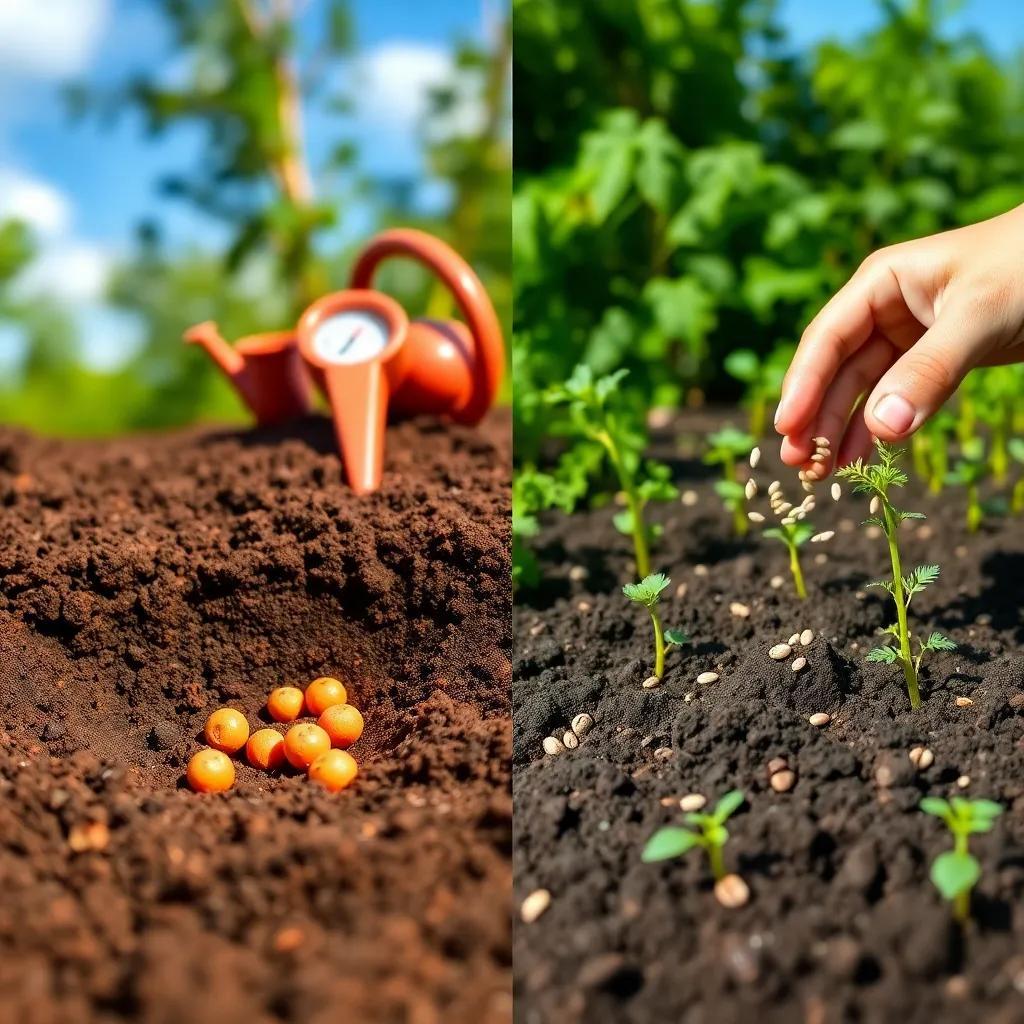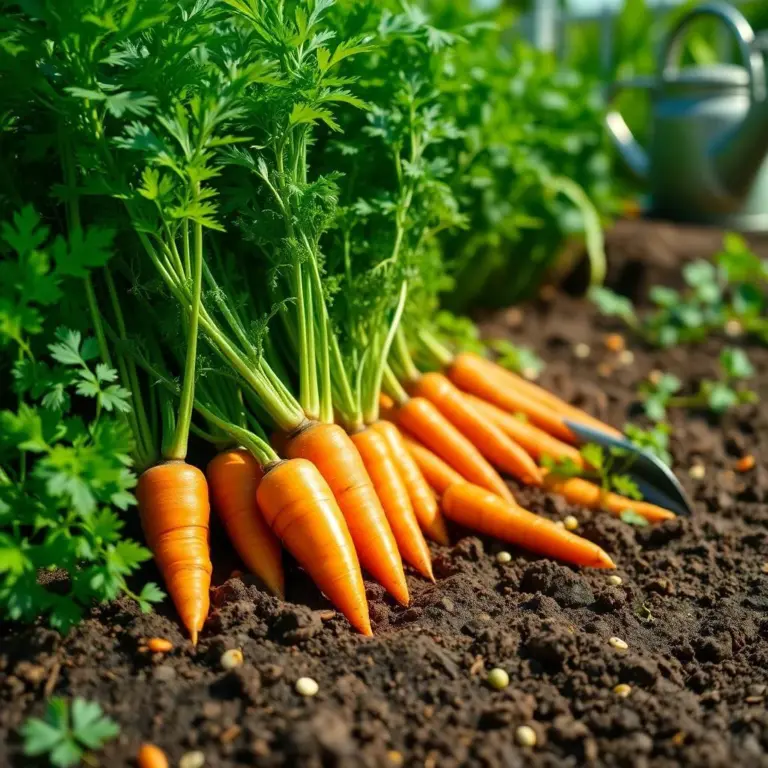Growing carrots can be one of the most rewarding experiences in the garden! From the eager anticipation of tiny seeds sprouting to the sweet crunch of freshly harvested carrots, there’s so much joy to be found in this delightful process. So, let’s dig into the essential tips and tricks that will help you cultivate the perfect crop of carrots—trust me, your taste buds will thank you!
Factors That Influence Carrot Seed Germination
Growing carrots can be super fun, but did you know that several factors can impact how well your seeds germinate? Understanding these will help you grow the best carrots ever! Let’s break down the important things to keep in mind.
- Soil Temperature: Carrot seeds are a bit picky about temperature. They like it cool but not too cold! The sweet spot is between 50°F (10°C) and 85°F (29°C). If it’s too chilly, they might take forever to sprout. Too hot, and they could just give up altogether!
- Moisture Levels: Seeds need their beauty sleep, and for them, that’s a cozy bed of moist soil. Carrots like it consistently moist, not soggy! If the soil is too dry, your seeds won’t germinate. Meanwhile, if it’s too wet, they could rot. That’s not a fun way to start!
- Seed Quality: I always say, “Fresh is best!” So, use high-quality seeds from a reputable source. Old or poor-quality seeds can lead to sad, weak plants that just don’t want to grow. Trust me, you want your seeds to be fresh and lively!
- Seed Depth: Planting depth matters, too! Since carrot seeds are tiny, they should be sown about 1/4 to 1/2 inch deep. If they’re too deep, they’ll have a tough time reaching the surface. Too shallow? They may not have enough soil contact to get started!
- Weed Competition: Weeds can be sneaky little critters that steal nutrients and space from your carrot seeds. Keeping your garden bed weed-free is essential for giving your carrots the best chance to grow.
So, keep these factors in mind! With a little love and attention, you’ll set the stage for gorgeous carrot plants that will make your garden the talk of the town!
Steps for Sowing Carrot Seeds Successfully
Alright, garden buddies! Now that we know what makes carrot seeds tick, let’s get our hands dirty and learn how to sow those seeds like a pro! Here’s my friendly guide to planting carrot seeds:
- Choose the Right Spot: Carrots love sunshine! Aim for a sunny spot in your garden that gets at least 6 to 8 hours of light daily. Also, choose well-draining soil. If your soil is too heavy or rocky, your carrots could end up stunted or misshapen!
- Prep the Soil: Before planting, clear away weeds, stones, and debris. We want our carrots to have a nice, clean home! Loosen the soil to about 8 inches deep. This helps the roots grow happily, without any roadblocks.
- Sow the Seeds: Time for the fun part! Gently broadcast the seeds over your prepared soil. Space them about 2 inches apart. Don’t worry—carrot seeds are tiny and can be a bit tricky! Just give them a light covering of soil, about ¼ inch thick. They’re not drama queens; they can handle a little dust!
- Watering: After sowing, give the soil a gentle shower—but not too hard! Use a fine mist to avoid washing away your precious seeds. Keep the soil evenly moist while you wait for those little sprouts to appear.
- Thinning: Once the seedlings pop up, it’s time to do some thinning! This means pulling out a few seedlings to make sure each plant has about 2 to 3 inches of space. It helps avoid overcrowding and allows your carrots to grow plump and juicy!
By following these simple steps, you’re well on your way to growing the best carrots ever. Trust me, with a little patience and care, you’ll soon have an amazing crop of crunchy, sweet carrots ready to enjoy! Happy planting!

Optimal Growing Conditions for Healthy Carrots
Growing carrots is a delightful adventure, and creating the perfect environment for them is key to success! Like us, carrots have their preferences, and when you meet those, they reward you with delicious, crunchy roots. Here are the essential conditions you need to provide:
- Sunlight: Carrots thrive in the sun! Aim for at least 6 to 8 hours of direct sunlight daily. A sunny spot in your garden will help them grow strong and sweet. If they don’t get enough light, they might become small and misshapen.
- Soil: Carrots love loose, well-draining soil—think sandy loam! Heavy clay can stunt their growth, resulting in crooked or forked roots. To improve drainage, mix in organic matter like compost or well-rotted manure. Trust me, your carrots will thank you!
- pH Level: The ideal soil pH for growing carrots is between 6.0 and 6.8. You can easily check this with a simple pH test kit. Proper pH levels help your carrots absorb nutrients, which keeps them happy and healthy!
- Watering: Consistent moisture is key! Keep the soil evenly moist but not waterlogged. It’s like giving your carrots a refreshing drink but not a drowning! In warmer weather, you might need to water them more frequently.
- Weed Control: Weeds are like party crashers—they compete with your carrots for nutrients and water. Pull them out regularly to give your carrots the best chance to shine!
By meeting these growing conditions, you’ll create a happy home for your carrot plants, and soon, you’ll be standing in your garden marveling at your beautiful, tasty carrots!
Understanding the Timeline from Seed to Harvest
Ah, the excitement of waiting for carrots to grow! Knowing the timeline from seed to harvest helps you plan your gardening adventure. Carrots usually take around 70 to 80 days from planting to harvest, but this can vary based on the variety and conditions. Here’s a breakdown of what to expect along the way:
- Germination: After sowing, carrot seeds typically take about 14 to 21 days to sprout. This can be longer in cooler temperatures, so patience is key! Remember, not all seeds sprout at the same time—some take their sweet time.
- Seedling Stage: Once your seeds germinate, you’ll start to see tiny seedlings pop up! They may be delicate, but they are full of potential. During this stage, make sure to keep the soil consistently moist, and thin them out to avoid overcrowding.
- Vegetative Growth: About 4 to 6 weeks after germination, your carrots will enter the vegetative growth stage. They will produce a bushy green top, and it’s essential to maintain moisture and protect them from pests during this period.
- Root Enlargement: Around 6 to 10 weeks after planting, you’ll notice the exciting part—your carrot roots will start to grow larger! This is when they begin to take shape and size. Keep an eye on moisture; it’s critical during this time.
- Maturity and Harvest: Finally, around 70 to 80 days after sowing, your carrots will reach maturity! Look for roots that are about 1/2 to 1 inch in diameter. They are ready to be pulled and enjoyed!
By understanding this timeline, you can enjoy the anticipation of your garden’s growth and prepare for the delicious harvest ahead!
Tips for Harvesting and Storing Carrots
The time has come! Harvesting carrots is one of the most rewarding parts of gardening, and I’m here to share some friendly tips to help you do it right. Here’s what you need to know:
- When to Harvest: Timing is everything! Carrots are best harvested when they’re about 1/2 to 1 inch in diameter. This usually happens around 70 to 80 days after planting. If you’re unsure, gently pull one up to see if it’s the right size!
- Loosening the Soil: Before you pull out those beauties, gently loosen the soil around the carrots using a garden fork or shovel. This helps prevent them from breaking and makes harvesting much easier.
- Pulling Technique: To harvest, grasp the green foliage at the top of the carrot and carefully pull it out, wiggling slightly as you go. This way, you’ll avoid damaging the root. It’s like giving your carrots a gentle hug and thanking them for their growth!
- Trimming: Once harvested, trim the leafy tops to about 1/2 inch above the carrot crown. This helps prolong their freshness. Avoid washing them until you’re ready to enjoy them—dirt helps keep them fresh!
- Storage: Store your harvested carrots in a cool, dark, and humid place. A root cellar is excellent if you have one! If you’re using a fridge, place them in a plastic bag in the vegetable crisper. This helps maintain moisture.
With these tips, you’ll be able to savor every bite of your homegrown carrots! Remember, the sweeter the carrot, the happier the gardener! Happy harvesting!

